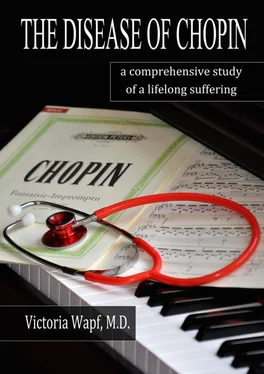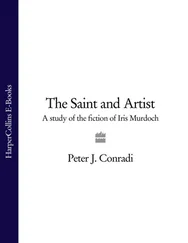Siblings
The older sister, Louise Chopin or Ludwika Marianna Jędrzejewiczowa (April 6, 1807 – October 29, 1855) suffered from recurrent chest infections and died from a respiratory illness at the age of 47 years 66 66 a). Kuzemko, J. (1994), “ Chopin’s illnesses ”. J Roy Soc Med 87 , 769—772. b). Caruncho, V. M., Fernandez, B. F. (2011), “ The hallucinations of Frederic Chopin ”, Medical Humanities 37 (1), 5—8.
. She was outlived by her four children. Chopin’s second sister, Isabelle Chopin or Justyna Izabella [битая ссылка] Barcińska (born on the 9th of July, 1811, died on the 3rd of June, 1881) had reportedly good health, “led an uneventful life and died at 70 years” 67 67 Kuzemko, J. (1994), “ Chopin’s illnesses ”. J Roy Soc Med 87 , 769—772.
. Her marriage to Anthony Barcinski remained childless 68 68 a). Clavier, A, (1984), “ Dans l’entourage de Chopin ”. vol. 2 , Lens. b). Mysłakowski,, P, Sikorski (2005) A, “ Chopinowie. Krąg rodzinno-towarzyski ”, Warszawa. c). J. Siwkowska (1986—1996) “ Nokturn czyli rodzina Fryderyka Chopina i Warszawa w latach 1832—1881 ” [A Nocturne. Fryderyk Chopin’s family in the years 1832—1881], vols. 1 —3 , Warsaw.
.
The youngest sister, Emily Chopin (aka Emilia Chopin) lived only fourteen and half years long (1812 – 1827). She was described as a frail child; from the early age her health was a subject of concern. She was underweight and suffered from periodic bouts of cough, breathlessness and ‘asthma’ (episodes of wheeziness). With regards to Emilia’s symptoms, which became especially severe when she was about eleven years old, the biographers opinions vary. Some researchers suggest that she started to have hematemesis and consequently died from a massive gastrointestinal hemorrhage, most likely from portal hypertension due to cirrhosis or severe gastric erosion 69 69 a). Kuzemko, J. (1994), “ Chopin’s illnesses ”. J Roy Soc Med 87 , 769—772. b). Marek, G.R., Gordon-Smith M. (1978) “Chopin”. New York: Harper & Row, as cited in Caruncho (2011) and Reuben, G. (2003), “ Chopin’s serpin ”. Hepatology Volume 37 , Issue 2 , 485—8, retrieved on 14 Februar 2014 from [битая ссылка] http://web.archive.org/web/20100312185417/http://en.chopin.nifc.pl/chopin/persons/detail/cat/9/id/6368:
. Yet other biographers consider her symptoms mostly pulmonary, noting Emilia’s frequent respiratory infections and syncopes. They refer to Emilia’s blood spitting as hemoptysis, not hematemesis, and suggest that she had pneumonia in her terminal phase:
“From her early childhood Emilia’s health was a matter of growing concern. Early symptoms of an illness (probably tuberculosis) caused a general weakness of the organism… Despite medical attempts (whose efficiency has been questioned and even accused of having speeded up her death) Emilia’s illness quickly developed and she spent her last months coughing with blood and often losing her senses”. 70 70 a). Ganche, E. (1935), “ Souffrances de Frederic Chopin. Essai de médecine et de psychologie”. Paris: Mercure de France. b) Myslakowski, P. & Sikorski, A. (2006), “ Justyna Chopin ”.
In a letter to a friend as of March 14 th1827, Chopin describes his sister’s sufferings that lasted already four weeks. He also describes Emilia’s anorexia and the treatment she received:
«…the bloodletting, which was done once, twice, innumerable leeches, vesicle-producing plasters, mustard plasters, and herbs, adventures over adventures. During this whole period of time, she did not eat and was so run down that one could hardly recognize her, and only slowly did she somewhat recuperate.” 71 71 as cited by Ganche, E. (1935), “ Souffrances de Frederic Chopin. Essai de médecine et de psychologie”. Paris: Mercure de France, p.117.
, 72 72 Kuzemko, J. (1994) and Marek G.R., Gordon-Smith M. (1978) “Chopin”. New York: Harper & Row, as cited by Caruncho, J. (2010) and Reuben, A. (2003), “ Chopin’s serpin ”, Hepatology Volume 37 , Issue 2 , 485—8, retrieved on the 14 th August 2014 from [битая ссылка] http://web.archive.org/web/20100312185417/http://en.chopin.nifc.pl/chopin/persons/detail/cat/9/id/6368:
Emilia died less than a month later, on the 10 thof April, 1827. There is no sufficient data to say with confidence whether Emilia’s death occurred on the grounds of a pathological process in her lungs with or without portal hypertension or due to a gastrointestinal disease. Depending on the initial pathology, it is possible that her death was caused by cachexia and anemia, both probably exacerbated by the wrong treatment Though chronic iron deficiency may rarely lead to death directly, a severe (or even moderate) anemia can cause sufficient hypoxia to aggravate underlying comorbidities (in Emilia’s case pulmonary and, probably gastrointestinal disorders) 73 73 Harper, J., Besa, E., Conrad, M., Sacher, R., Schick, P. (2013), “ Iron Deficiency Anemia ”, Medscape, retrieved from http://emedicine.medscape.com/article/202333-overview#showall on Tuesday, February 11, 2014.
and become lethal this way.
Speaking of an exacerbating treatment, bloodletting (or bleeding) was widely practiced at that time and, according to Frederic’s accounts, Emilia Chopin underwent this treatment, too. It is important to note that the regular amount of blood extracted on each occasion was substantial: 600 – 1 000 ml. The treatment regime varied and Emilia might lose close to 2 800 ml of blood in three days, or 3 000 ml in 4 days. As much as 6 200 ml of blood could be let over a six day period 74 74 a). Ogle, J. (1891), “ Concerning bloodletting ”, The Lancet 137 (3532), 1029—1032. b). Turk, J. L., Allen, E. (1983), “ Bleeding and cupping ”, Ann R Coll Surg Engl 65 (2), 128 – 131.
. In total, Emilia was losing blood – both as a result of her disease and her treatment – at least eight week long. Taking into consideration that patients at that time were regularly bled to syncope 75 75 Turk, J. L., Allen, E. (1983), the same as above.
and both her nutritional status and food/liquids intake were absolutely inadequate, the cause of death could well be a posthemorrhagic anemia, and not an underlying pulmonary or gastrointestinal disease. With Emilia’s prolonged history of treatment with bleedings, an iatrogenic infection, such as hepatitis B virus (HBV), remains a possibility, too. Such infection may have affected the hepatocellular function, interfering with production of thrombopoetin. The resulting thrombocytopenia could additionally contribute to the Emilia’s hemorrhages, and, finally, to her death.
Living arrangements
Chopin’s living arrangements varied greatly. Reportedly, he had never owned a house himself and lived in rented accommodations, at times sharing them with friends. It is likely that many of his dwellings have helped to an exacerbation of Chopin’s pulmonary symptoms and progression of disease:
– Fireplaces and cooking stoves – are all known sources of irritants of the upper airways
– Cold damp dwellings (for example, the one on Mallorca).
– Mold and fungae are regularly present in damp settings and may have contributed to Chopin’s cough bouts, too (Szpilczynski) discussed Chopin’s allergic predisposition in 1961 76 76 Szpilszynski, S. (1961) “ War Chopin Allergiker?”. Ciba-Symposium 9 (6): 283—289.
).
Marital status / Children
While known for having had numerous sexual relationships – some of them lasted for years – Chopin was never married and no biological children are known.
Читать дальше












